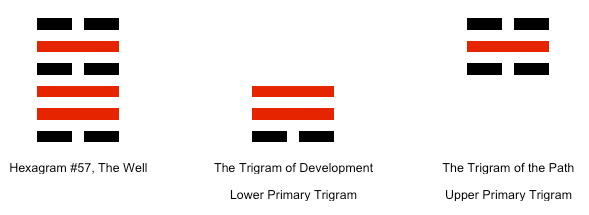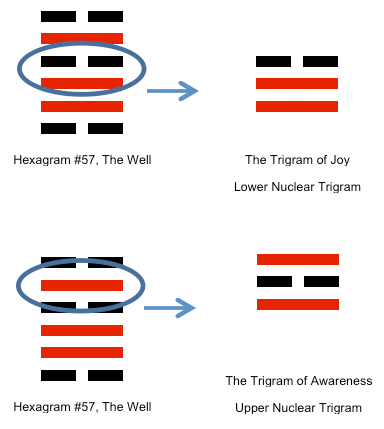|
The Three Stages of Change of Yang and Yin
Creative awareness travels through our universe in waves. As it moves it exhibits contrasting
characteristics. Yang and Yin energy are contrasting facets of this Creative Spirit. The two exist in balance with each other, ebbing and flowing, providing the differing qualities required for creative experience.
Yang begins as pure creative force, it then furthers all it comes in contact with, and finally it
inspires everything that surrounds it. Yin appears as unlimited receptivity, then manifests in balance with its environment, and completes itself through total flexibility which allows it to transform back into Yang.
I call these qualities the three stages of change of Yang and Yin (please see exhibit "Stages of Change").
A moving line exhibits one of these characteristics depending upon its position within each Trigram.
Moving Lines
There are four qualities of lines available in the flipping and counting process. A value of 7 or 8
produces a solid and a broken line. These represent the resting postures of Yang and Yin. They remain
the same quality in the initial Hexagram and in the Hexagram obtained after the change (see the next
chapter "The Process" for a further explanation of the changing Hexagrams).
A value of 6 or 9 however produces an "old Yin" or "old Yang" line. For a value of 9, "old Yang"
is represented by a straight line with a circle or sphere in the middle. A value of 6 produces "old Yin", a broken line with an "X" in the middle. These mature lines are about to follow their natural instinct to change into their contrasting qualities, Yang into Yin and Yin into Yang. It is these lines that have an additional power in the creative process.
Moving Yang lines have images and qualities that are described in the 6 lines of Hexagram #1,
Chi'en, Creative Spirit. Yin lines have characteristics and results that are identified in Hexagram #2, K'un, Existence. When a moving line is obtained in a flipping or counting, these images and characteristics become operative, and further describe the unfolding energy pattern of the current creative experience.
Please see the exhibits "Yang Line Images and Qualities" and "Yin Line Characteristics and Results".
In addition to the quality of the lines in the Hexagram, moving lines also highlight specific
characteristics with each Trigram that they reside.
Primary and Nuclear Trigrams
Within each Hexagram there are four Trigrams. There are the two primary Trigrams. The lower
primary Trigram is made up of lines 1, 2, and 3. The upper primary Trigram consists of lines 4, 5 and 6.
In Hexagram #57, The Well, the lower primary Trigram is Development and the upper primary Trigram
is the Path.

There are also two additional trigrams called the lower and upper nuclear Trigrams of the
Hexagram. It is said that the main idea of the Hexagram is described in the primary Trigrams, but the
flavor of the idea can't be discerned without contemplating the nuclear Trigrams. The lower nuclear
Trigram is made up of lines 2, 3 and 4. The upper nuclear consists of lines 3, 4 and 5.

The basic idea of The Well is "Development of the Path". Adding the nuclear Trigrams, the
idea expands to "Development of the Path through the Joy of Awareness". This provides for an expanded
idea and better understanding of the current creative experience.
As we've discussed, moving lines highlight specific characteristics within each Trigram that they
reside. If a moving line is obtained in lines 1, 2, or 3 it resides in the lower primary Trigram. If in lines 4, 5, or 6 it is in the upper primary Trigram. We have now learned that if a moving line occupies lines 2, 3, or 4 it also is in the lower nuclear Trigram. Moving lines in positions 3, 4, or 5 put that line in the upper nuclear Trigram. Every moving line maintains its stage of change depending upon its position in each Trigram.
A moving Yang line in the lower position of its Trigram has the quality of creativity. In the
middle position, its quality is furthering. In the top position, it is inspiring. A Yin line in the first position of its Trigram has the characteristic of receptivity. In the middle position, it is balanced and at the top it is flexible. The final pieces of information regarding the Hexagram are determined by analyzing the position of each moving line within the four Trigrams of the Hexagram. The exhibit "Table of Trigrams" outlines the three stages of change of Yang and Yin within each Trigram.
This idea is discussed further in "The Process".
| 
















